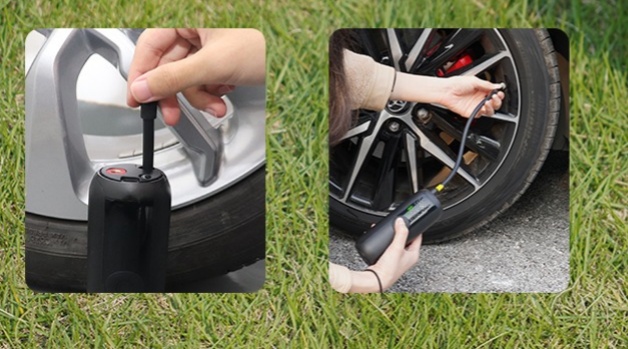An electric air compressor is one of the handiest tools for any auto owner. Keeping your pump properly maintained ensures it works reliably for years to come.
This article provides top maintenance tips to get the longest lifespan and best performance from your electric air pump.

The benefits of proper maintenance
Routine care and servicing provides:
- Extended pump lifespan so you get the full value from your investment. Well-maintained units can operate for decades.
- Optimized pumping performance so tires inflate quickly every time. A well-tuned pump works like new.
- Enhanced safety by identifying and replacing worn parts before they fail. Safety valves and gauges work properly.
- Lower operating costs from improved energy efficiency and fewer repairs needed. Proper care reduces expenses.
- Prevention of breakdowns that leave you stranded with a flat tire on the roadside. Reliable operation gives you peace of mind.
Regular maintenance checklist
Follow this periodic maintenance schedule to keep your electric air pump running flawlessly:
Every use: Wipe down the exterior and neatly store it indoors away from dirt, moisture and temperature extremes
Monthly:
- Check air filters and wash or replace them if dirty
- Inspect electrical cord condition and connections
- Confirm pump wheels/legs roll smoothly
Every 6 months:
- Check belt tension and adjust as needed
- Test check valve and pressure relief valves
- Drain moisture from air tanks
- Clean air intake areas of debris
Annually:
- Change oil and oil filters per manufacturer specifications
- Replace air filters and worn accessories like hoses, fittings, and nozzles
- Confirm safety valves function properly
- Test pump performance and gauge accuracy
Every 2-3 years:
- Replace hydraulic oil in oil-lubricated pumps
- Rebuild/replace critical valves and seals
- Inspect cylinder sleeves and rods
- Replace capacitors and motor brushes
As needed: Inspect and replace damaged gauges, wiring, gaskets, and pulleys immediately
Air filter maintenance
Dirty air filters lead to reduced performance and pump damage.
- Inspect intake filters monthly and clean or replace them if dirty.
- Use compressed air to blow out loose debris. Avoid washing filters if possible.
- Refer to operating hours for recommended replacement intervals.
- Only use manufacturer-approved air filters. Improper filters damage pumps.
Moisture management
Moisture causes corrosion inside tanks and lines.
- Drain air tanks regularly via tank drain valves. Drain after every use in humid environments.
- Install inline air dryers to remove moisture before it enters tanks. They prolong pump life.
- For oil-lubricated pumps, change oil twice as often in humid areas to combat moisture contamination.
- After draining the tanks, run the pump briefly to purge any residual moisture.
Lubrication system upkeep
Proper lubrication prevents wear and overheating.
- Change pump oil and oil filters as specified in the owner’s manuals. Don’t exceed recommended intervals.
- Use only approved manufacturer oils. General-purpose oils can damage pumps.
- Replace oil immediately if it appears contaminated, milky or diluted.
- Check oil sight glasses on electric pumps to confirm the oil level. Top off as needed.
- Lubricate cylinder sleeves, rods and other friction points with approved lubricants.

Pressure system checks
The pressurized components keep compressed air contained.
- Annually test check valves and pressure relief valves. Replace faulty ones immediately.
- Replace head gaskets and o-rings when rebuilding pumps to maintain compression seal. Use only original manufacturer parts.
- Check belts for cracking or glazing and replace them at intervals recommended for your model. Buy belts in sets.
- Listen for air leaks and have seals replaced if you hear hissing sounds. Leaks reduce performance.
Motor and electrical
The motor and electrical system provide power.
- Clean motor exterior and ventilation openings regularly with compressed air to ensure airflow.
- Replace motor brushes as needed. Excessively worn brushes damage the armature.
- Use dielectric grease on electrical connectors and control boards to prevent corrosion.
- Check capacitors and have them replaced every 2-3 years or if the pump won’t start.
- Monitor cord condition closely. Replace cords with cracked insulation or exposed wires.
Gauge accuracy
Inaccurate gauges lead to improper and unsafe tire inflation.
- Annually test gauge accuracy with an inline master gauge. Recalibrate if off by more than 2–3 psi.
- Replace gauges that cannot be recalibrated to like-new accuracy. Inaccurate gauges mislead users.
- Only use manufacturer-approved replacement gauges. Aftermarket units often don’t integrate properly.
- Install protective rubber gauge covers to prevent damage from drops, abrasions and dirt.
Accessory replacement
Worn accessories negatively impact performance.
- Replace accessories like filters, fittings and hoses at intervals recommended for your model. Don’t wait for them to fail.
- Only use high-quality replacement accessories that meet or exceed OEM specifications. Cheap parts fail prematurely.
- Have backup common wear items like filters, connector tips and air hoses on hand so you can quickly replace them when needed.
Protect from the elements
Environmental factors shorten pump lifespans.
- Store the pump in a clean, dry space away from rain, moisture, dust and dirt.
- Avoid exposing the pump to temperature extremes. Do not store in non-climate-controlled spaces with high humidity.
- When using a pump outdoors, place a plastic cover or tarp over it during downpours. Never spray down the pump to clean it.
- In outdoor storage, enclose the pump in a protective housing or cover that still allows adequate airflow.
Professional overhauls
Periodic professional servicing provides in-depth maintenance and calibration.
- Every 2-5 years, take the pump to an authorized service center for a full check-up.
- The overhaul will thoroughly inspect, replace and calibrate components to keep the pump working like new.
- Overhauls extend pump lifespan by identifying issues and making repairs before problems occur.
- Always use factory-certified service technicians. Unauthorized repairs often void warranties.
With periodic maintenance performed properly, your electric air compressor will provide reliable service for 10-15 years or more. These tips maximize your pump’s lifespan, capabilities and return on investment. Schedule maintenance diligently and your pump will deliver optimized air power performance for many years to come.
Troubleshooting common electric pump problems
Even well-maintained pumps can sometimes develop issues. Here’s how to troubleshoot common electric air compressor problems:
Pump won’t start
- Check power connections and wiring for damage.
- Test the outlet with a lamp to confirm the power is present. Try another outlet.
- Reset the circuit breaker or replace blown fuses.
- Make sure the unit is plugged into an outlet, not just an extension cord.
- For gas engines, check the fuel level. Make sure the choke is open once started.
- Replace faulty start capacitors that prevent motor turnover.
- Test and replace damaged on/off switches or pressure switches.
Pump runs but doesn’t compress air
- Listen for air leaks and re-seal leaky gaskets, valves or connections.
- Make sure to check valve seals properly to build air pressure.
- Examine piston rings for wear and replace damaged piston assemblies.
- Check for stuck or dirty discharge valves and clean or replace them.
- Confirm belts are tensioned properly and not slipping.
- Replace worn piston wrist pins or connecting rods that slip.
- On oil-lubricated pumps, verify proper oil levels in the crankcase.
Tank pressure drops when compressor shuts off
- Listen for any air leaks from loose fittings, valves or seals and tighten connections or replace damaged parts.
- Inspect check valve operation to confirm it seats properly when closed. Replace faulty valves.
- Make sure air tank drain valve is fully closed. Open to drain moisture after use.
- Check for cracks in air tank welds or leaks from corrosion pinholes. Have the tank tested and re-welded or replaced if needed.
Excessive pump noise/vibration
- Confirm pump rests solidly on a level surface and doesn’t vibrate or move during operation.
- Check for loose pulleys, guides, bolts or fittings that may rattle when running. Tighten appropriately.
- Replace bearings making grinding or whining noises indicating wear.
- Clean out debris that may have been collected in the pump head or cooling fins.
- Have the motor inspected for misalignment, worn bearings, bent shaft or loose components.
- Balance faulty flywheels that cause excessive vibration.
Overheating problems
- Reduce run time and allow for cooling periods during extended use. Don’t run continuously for more than 10 minutes.
- Make sure cooling fins and ventilation openings are clean and unobstructed.
- Check for adequate airflow around the unit. Don’t enclose in small unventilated spaces.
- Lower ambient temperatures by shading the compressor from direct sunlight during warm days.
- Replace seized or stuck piston rings allowing hot gas to bypass.
- Refill low oil levels that reduce lubrication and cooling inside the pump.
- Confirm capacitors are operating properly and replace any bulged, cracked or leaking units.
With basic troubleshooting, you can resolve many common electric air pump issues yourself. But for complex repairs involving electrical or mechanical components, always consult a trained technician. Performing diligent maintenance and repairs will keep your compressor running optimally for the long term.

Best practices for maximizing electric pump longevity
Get the longest possible lifespan from your electric air compressor by following these best practices:
Purchase quality from reputable brands
- Invest in leading brands known for performance, quality manufacturing and durability.
- Look for pumps with all-metal construction, not plastic housing which can crack and warp.
- Choose established companies that have been in business for decades and stand behind their products.
Review pump duty ratings
- Match your usage needs to the recommended duty cycle rating for the model. Intermittent-use pumps can’t withstand heavy daily use.
Allow for proper airflow
- Position the pump in well-ventilated areas away from heat sources with at least 12 inches of clearance around the unit.
Use filtered air intake
- Install an intake air filter to remove contaminants from incoming air that can damage internal pump components.
Maintain proper oil levels
- Check oil levels regularly on lubricated pumps and top off when low to prevent mechanical wear.
Follow maintenance intervals
- Stick closely to all maintenance schedules for cleaning, filter changes, lubrication and parts replacement.
Let pump cool between uses
- Don’t run the pump continuously for more than 10-15 minutes. Allow proper cool-down periods to prevent overheating damage.
Keep pump clean
- Always wipe down the exterior after use and store it in a clean, dry space away from environmental debris and moisture.
Use a backup pump
- Have a second pump available for emergencies if your primary pump goes down for service or repair.
Install a moisture filter
- Use an inline air dryer to filter moisture from compressed air before it enters the pump.
Avoid cheap accessories
- Only use manufacturer-approved replacement parts and accessories. Low-quality components shorten their lifespan.
Proper use and care will give you decades of reliable service from a quality electric air compressor.
Follow these tips and your pump will deliver optimized air power performance for many years to come. Invest in maintenance and your pump will reward you with maximum longevity.













